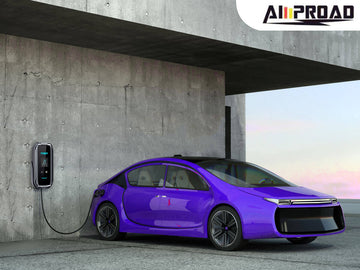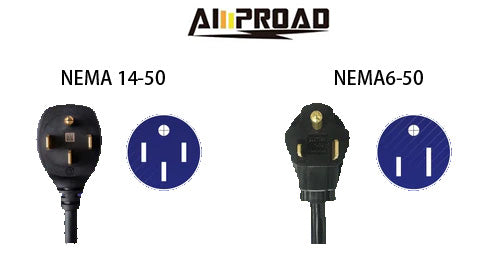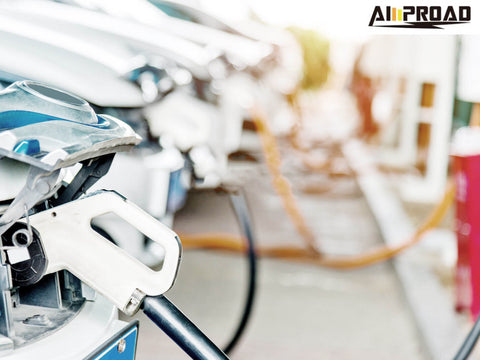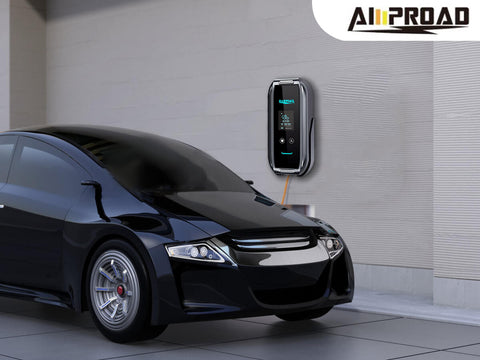
Navigating the world of electric vehicles (EVs) often brings you face to face with charging considerations, and understanding the difference between NEMA 6-50 and NEMA 14-50 can significantly impact your charging experience, especially when it comes to home charging. These two outlet types are commonly used for Level 2 EV chargers, but they have key distinctions in wiring, grounding, and compatibility. Choosing the right option depends on factors such as electrical setup, charger requirements, and long-term flexibility, making it essential to assess which best suits a specific EV charging setup.
Distinguishing Between NEMA 6-50 and NEMA 14-50 Outlets: A Comprehensive Comparison
For most drivers, EV home charging is the preferred method, and investing in a reliable home charging station is key. The two prominent plugs in this realm are the NEMA 6-50 and NEMA 14-50, both capable of delivering a maximum of 50 amps of power, ideal for efficient EV charging at home.
The NEMA 14-50 outlet stands out as the more popular and versatile choice, thanks to its widespread availability and capacity to handle higher power devices. While the NEMA 6-50 may not be as prevalent, it competes favorably with its counterpart in terms of versatility, boasting easier installation and greater flexibility.

Examining the structural distinction between the two reveals a crucial difference: the NEMA 6-50 lacks a neutral wire, featuring three holes for two hots and a ground wire. In contrast, the NEMA 14-50 incorporates four holes, adding a neutral wire to the mix.
It's essential to clarify the distinction between the plug and the electric vehicle (EV) charging connector. The plug connects to your wall outlet, while the EV charging connector interfaces with your electric car. The Level 2 EV charger requires either hardwiring or connection to a heavy-duty outlet, like those used for electric ovens, with the recommended voltage of 240 volts and a maximum safe charging amperage of 50 amps.
The NEMA 14 50r outlet, a 240-volt plug with 50 amps, finds common usage in RV parks and mobile homes, offering a convenient charging solution for electric vehicles, providing a full charge in under six hours with the right Level 2 charger. It's noteworthy that mobile chargers often feature a NEMA 14-50 plug, enabling direct connection without the need for hardwired installation.
On the other hand, the NEMA 6-50 plug, also supporting higher power devices, has found applications in generators and compressors but has expanded its utility to power electric vehicles, notably used by Tesla with the assistance of an adapter. This plug type can deliver up to 9.6 kWh or 30-35 miles of range per hour, making it one of the swifter residential charging options.
Considering the benefits, the NEMA 14 50r has an edge in terms of future-proofing, as upcoming EVs may phase out the 6-50 receptacle option. Its widespread availability across the nation makes it more common and easier to find. However, the NEMA 6-50 has its advantages, being more budget-friendly and simpler to install due to its smaller cross-section and fewer wires, enhancing flexibility.
Addressing common queries, it's clarified that the NEMA 6-50 plug cannot be plugged into the 14-50 receptacle due to structural differences. The NEMA 14-50 is frequently used for higher power devices like stoves and dryers. The choice between 6-50 and 14-50 comes down to personal preferences, with the 14-50 being more common nationwide.
For Tesla owners, the 240-volt NEMA 14-50 outlet is the recommended home charging installation. Hiring a licensed electrician is crucial to adding a dedicated breaker to your GFCI circuit breaker for accommodating the EV wall charger. The Mobile Charger, which comes with a 14-50 adapter, provides flexibility for different charging scenarios.
In terms of installation costs, setting up a NEMA 14-50 outlet ranges between $500 to $2,500, emphasizing the importance of employing a qualified electrician for the task. In essence, understanding the nuances between NEMA 6-50 and NEMA 14-50 is pivotal in optimizing your EV charging setup, ensuring a seamless and efficient charging experience at home.
What is a NEMA 14-50 outlet used for?
The NEMA 14-50 outlet, renowned for its versatility and high power capacity, serves various electrical needs, including the charging of electric vehicles (EVs). Specifically, when paired with the Amproad 14-50R EV adapter cord, this outlet becomes an essential component for Level 2 EV charging. The Amproad adapter cord enables a seamless connection between the NEMA 14-50 outlet and the EV charger, ensuring a reliable and efficient charging experience. While sometimes your electric car won't start, you should inspect if it's lack of battery.
Beyond EV charging, the NEMA 14-50 outlet, with the assistance of the Amproad adapter cord, proves beneficial for RV connections, delivering a robust power supply for recreational vehicles at home or campgrounds. Its 50-amp capacity is well-suited for meeting the power demands of RVs and their associated appliances.
Moreover, the NEMA 14-50 outlet, in conjunction with the Amproad adapter cord, is a practical choice for powering heavy-duty home appliances like electric stoves, ovens, and clothes dryers. This combination ensures a dependable electrical connection, catering to appliances with substantial power requirements.
In construction sites and workshops, the Amproad 14-50R EV adapter cord extends the application of the NEMA 14-50 outlet, allowing for the efficient operation of power-hungry tools and equipment.
What is a 6-50 plug used for?
The NEMA 6-50 plug is a robust and high-power electrical outlet designed for specific applications that demand substantial current capacity. With a unique configuration, featuring three flat pins and a ground pin, the NEMA 6-50 plug is commonly used for welding equipment, making it a staple in workshops, garages, and industrial settings.
This outlet is tailored for welding machines, providing a reliable power source for equipment that requires a 240-volt power supply. The NEMA 6-50 plug's 50-amp rating ensures a robust and consistent electrical flow, meeting the demands of welding processes that involve higher currents.
In environments where welding is a frequent or primary activity, the NEMA 6-50 plug serves as a standardized and dependable power connection. Welders and fabricators rely on this plug to provide the necessary power for their welding machines, enabling efficient and effective operation.
The NEMA 6-50 plug's utilization is not limited to welding alone; it can also be found in settings where high-power equipment or machinery necessitates a 240-volt power supply. Overall, the NEMA 6-50 plug plays a crucial role in powering heavy-duty electrical appliances and machinery, particularly in industrial and workshop contexts.

Is NEMA 14-50 better than 6-50?
The choice between NEMA 14-50 and NEMA 6-50 depends on the specific requirements of the electrical application. Here are key considerations for each:
NEMA 14-50:
Voltage and Amperage: The NEMA 14-50 outlet provides a 240-volt power supply and is rated for 50 amps. It is commonly used for higher-power applications.
Neutral Wire: The NEMA 14-50r includes a neutral wire, making it suitable for applications that require both 120V and 240V power.
Applications: This outlet is commonly used for electric vehicle (EV) charging, RV power connections, and in residential settings for high-power appliances like ranges or dryers.
NEMA 6-50:
Voltage and Amperage: Like the NEMA 14-50, the NEMA 6-50 provides a 240-volt power supply, but it is also rated for 50 amps.
No Neutral Wire: Unlike the NEMA 14-50, the NEMA 6-50 does not have a neutral wire. It is a straight 240V circuit.
Applications: The NEMA 6-50 is commonly used for applications that require a high-power 240V circuit, such as welding equipment in industrial and workshop settings.
Choosing Between Them:
EV Charging: If the application involves electric vehicle charging, the NEMA 14-50 is often preferred due to its inclusion of a neutral wire, which some home EV charger require.
Welding: For welding equipment, both outlets are used, but the choice depends on the specific requirements of the welder in use.
Ultimately, the decision should be based on the specific needs of the equipment or application, considering factors like voltage requirements, the need for a neutral wire, and compatibility with the devices being powered.
Is NEMA 14-50r best for Tesla?

The NEMA 14 50r outlet is a popular and highly compatible choice for charging Tesla vehicles. This 240-volt outlet provides a robust 50-amp power supply, making it suitable for efficient Tesla charging. Tesla vehicles come with a Mobile Connector equipped with a NEMA 14-50 adapter, allowing users to plug directly into this common outlet.
For Tesla owners, the NEMA 14 50 is a versatile solution, offering a balance between charging speed and accessibility. It's commonly used for home charging setups, providing a reliable power source to replenish the vehicle's battery. The compatibility between Tesla's charging equipment and the NEMA 14-50 makes it a convenient and widely adopted choice for Tesla owners who seek an efficient and cost-effective home charging solution.
What is the installation cost associated with a NEMA 14-50 outlet?
The installation cost for a NEMA 14-50 outlet can vary based on factors like the location of the installation, local labor rates, and any additional materials needed. On average, homeowners can expect to pay anywhere from $200 to $600 for the installation of a NEMA 14-50 outlet. This cost includes the electrical wiring, outlet box, labor, and any necessary permits.
To make the most cost-effective choice for home charging, consider pairing the NEMA 14-50 outlet with the Amproad 14-50R cord. This adapter cord offers versatility and compatibility, ensuring seamless connectivity between your outlet and your electric vehicle (EV). Additionally, Amproad, a leading supplier of Level 2 EV chargers, provides a range of charging solutions, including the affordable and efficient Level 2 ev home charger. The combination of the NEMA 14-50 outlet, Amproad 14-50R cord, and Level 2 charger creates a comprehensive and cost-effective home charging solution for your EV.


